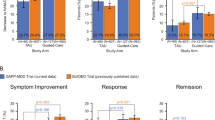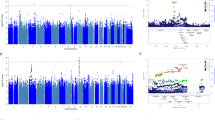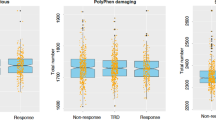Abstract
In four previous studies, a combinatorial multigene pharmacogenomic test (GeneSight) predicted those patients whose antidepressant treatment for major depressive disorder resulted in poorer efficacy and increased health-care resource utilizations. Here, we extended the analysis of clinical validity to the combined data from these studies. We also compared the outcome predictions of the combinatorial use of allelic variations in genes for four cytochrome P450 (CYP) enzymes (CYP2D6, CYP2C19, CYP2C9 and CYP1A2), the serotonin transporter (SLC6A4) and serotonin 2A receptor (HTR2A) with the outcome predictions for the very same subjects using traditional, single-gene analysis. Depression scores were measured at baseline and 8–10 weeks later for the 119 fully blinded subjects who received treatment as usual (TAU) with antidepressant standard of care, without the benefit of pharmacogenomic medication guidance. For another 96 TAU subjects, health-care utilizations were recorded in a 1-year, retrospective chart review. All subjects were genotyped after the clinical study period, and phenotype subgroups were created among those who had been prescribed a GeneSight panel medication that is a substrate for either CYP enzyme or serotonin effector protein. On the basis of medications prescribed for each subject at baseline, the combinatorial pharmacogenomic (CPGx™) GeneSight method categorized each subject into either a green (‘use as directed’), yellow (‘use with caution’) or red category (‘use with increased caution and with more frequent monitoring’) phenotype, whereas the single-gene method categorized the same subjects with the traditional phenotype (for example, poor, intermediate, extensive or ultrarapid CYP metabolizer). The GeneSight combinatorial categorization approach discriminated and predicted poorer outcomes for red category patients prescribed medications metabolized by CYP2D6, CYP2C19 and CYP1A2 (P=0.0034, P=0.04 and P=0.03, respectively), whereas the single-gene phenotypes failed to discriminate patient outcomes. The GeneSight CPGx process also discriminated health-care utilization and disability claims for these same three CYP-defined medication subgroups. The CYP2C19 phenotype was the only single-gene approach to predict health-care outcomes. Multigenic combinatorial testing discriminates and predicts the poorer antidepressant outcomes and greater health-care utilizations by depressed subjects better than do phenotypes derived from single genes. This clinical validity is likely to contribute to the clinical utility reported for combinatorial pharmacogenomic decision support.
This is a preview of subscription content, access via your institution
Access options
Subscribe to this journal
Receive 6 print issues and online access
$259.00 per year
only $43.17 per issue
Buy this article
- Purchase on Springer Link
- Instant access to full article PDF
Prices may be subject to local taxes which are calculated during checkout





Similar content being viewed by others
References
Zhou SF . Polymorphism of human cytochrome P450 2D6 and its clinical significance: part II. Clin Pharmacokinet 2009; 48: 761–804.
Mrazek DA . Psychiatric Pharmacogenomics. Oxford University Press: New York, NY, 2010.
Zanger UM, Schwab M . Cytochrome P450 enzymes in drug metabolism: regulation of gene expression, enzyme activities, and impact of genetic variation. Pharmacol Ther 2013; 138: 103–141.
Kirchheiner J, Nickchen K, Bauer M, Wong ML, Licinio J, Roots I et al. Pharmacogenetics of antidepressants and antipsychotics: the contribution of allelic variations to the phenotype of drug response. Mol Psychiatry 2004; 9: 442–473.
Mrazek DA, Biernacka JM, O'Kane DJ, Black JL, Cunningham JM, Drews MS et al. CYP2C19 variation and citalopram response. Pharmacogenet Genomics 2011; 21: 1–9.
Altar CA, Hornberger J, Shewade A, Cruz V, Garrison J, Mrazek D . Clinical validity of cytochrome P450 metabolism and serotonin gene variants in psychiatric pharmacotherapy. Int Rev Psychiatry 2013; 25: 509–533.
Conrado DJ, Rogers HL, Zineh I, Pacanowski A . Consistency of drug-drug and gene-drug interaction information in US FDA-approved drug labels. Pharmacogenomics 2013; 14: 215–223.
Citalopram (FDA): Package insert. http://www.accessdata.fda.gov/drugsatfda_docs/label/2009/020822s037,021046s015lbl.pdf.
Jürgens G, Jacobsen CB, Rasmussen HB, Werge T, Nordentoft M, Andersen SE . Utility and adoption of CYP2D6 and CYP2C19 genotyping and its translation into psychiatric clinical practice. Acta Psychiatr Scand 2012; 125: 228–237.
Recommendations from the EGAPP working group testing for cytrochrome P450 polymorphisms in adults with nonpsychotic depression treated with selective serotonin reuptake inhibitors. Genet Med 2007; 9: 819–825.
Dalén P, Dahl ML, Bernal Ruiz ML, Nordin J, Bertilsson L . 10-Hydroxylation of nortriptyline in white persons with 0, 1, 2, 3, and 13 functional CYP2D6 genes. Clin Pharmacol Ther 1998; 63: 444–452.
McAlpine DE, Biernacka JM, Mrazek DA, O’Kane DJ, Stevens SR, Langman LJ et al. Effect of cytochrome P450 enzyme polymorphisms on pharmacokinetics of venlafaxine. Ther Drug Monit 2011; 33: 14–20.
Jornil J, Nielsen TS, Rosendal I, Ahlner J, Zackrisson AL, Boel LWT et al. A poor metabolizer of both CYP2C19 and CYP2D6 identified by mechanistic pharmacokinetic stimulation in a fatal drug poisoning case involving venlafaxine. Forensic Sci Int 2013; 226: e26–e31.
Hall-Flavin DK, Winner JG, Allen JD, Carhart JM, Procter B, Snyder KA et al. Utility of integrated pharmacogenomic testing to support the treatment of major depressive disorder in a psychiatric outpatient setting. Pharmacogenet Genomics 2013; 23: 535–548.
Hall-Flavin DK, Winner JG, Allen JD, Jordan JJ, Nesheim RS, Snyder KA et al. Using a pharmacogenomic algorithm to guide the treatment of depression. Transl Psychiatry 2012; 2: e172.
Winner JG, Carhart JM, Altar CA, Allen JD, Dechairo B . A prospective, randomized, double-blind study assessing the clinical impact of integrated pharmacogenomic testing for major depressive disorder. Discov Med 2013; 16: 219–227.
Winner J, Allen J, Altar CA, Mihajlovic A . Genotype predicts health resource utilization of outpatients with anxiety and depression in a staff model health maintenance organization. Transl Psychiatry 2013; 3: e300.
Licinio J, Wong ML . Pharmacogenomics of antidepressant treatment effects. Dialogues Clin Neurosci 2011; 13: 63–71.
Herbild L, Andersen SE, Werge T, Rasmussen HB, Jurgens G . Does pharmacogenetic testing for CYP450 2D6 and 2C19 among patients with diagnoses within the schizophrenic spectrum reduce treatment costs? Basic Clin Pharmacol Toxicol 2013; 11: 266–272.
Rush AJ, Bernstein IH, Trivedi MH, Carmody TJ, Wisniewski S, Mundt JC et al. An evaluation of the quick inventory of depressive symptomatology and the hamilton rating scale for depression: a sequenced treatment alternatives to relieve depression trial report. Biol Psychiatry 2006; 59: 493–501.
Ballinger GA . Using generalized estimating equations for longitudinal data analysis. Organ Res Methods 2004; 7: 127–150.
Ma Y, Mazumdar M, Memtsoudis SG . Beyond repeated-measures analysis of variance: advanced statistical methods for the analysis of longitudinal data in anesthesia research. Reg Anesth Pain Med 2012; 37: 99–105.
Zhang D, Lin X Variance component testing in generalized linear mixed models for longitudinal/clustered data and other related topics. Unpublished thesis. Accessed on 5 August 2013; www4.stat.ncsu.edu/~dzhang2/st755/vartest.pdf.
Holm S . A simple sequentially rejective multiple test procedure. Scan J Statis 1979; 6: 65–70.
Gage BF, Eby C, Johnson JA, Deych E, Rieder MJ, Ridker PM et al. Use of pharmacogenetic and clinical factors to predict the therapeutic dose of warfarin. Clin Pharmacol Ther 2008; 8: 326–331.
Lohoff FW, Narasimhan S, Rickels K . Interaction between polymorphisms in serotonin transporter (SLC6A4) and serotonin receptor 2A (HTR2A) genes predict treatment response to venlafaxine XR in generalized anxiety disorder. Pharmacogenomics J 2012; 13: 464–469.
Villagra D, Goethe JW, Schwartz HI, Szarek B, Kocherla M, Gorowski K et al. Novel drug metabolism indices for pharmacogenetic functional status based on combinatorial genotyping of CYP2C9, CYP2C19 and CYP2D6 genes. Biomark Med 2011; 5: 427–438.
DeMartinis NA, Yeung PP, Entsuah R, Manley AL . A double-blind, placebo-controlled study of the efficacy and safety of desvenlafaxine succinate in the treatment of major depressive disorder. J Clin Psychiatry 2007; 68: 677–688.
Stahl SM . Placebo-controlled comparison of the selective serotonin reuptake inhibitors citalopram and sertraline. Biol Psychiatry 2000; 48: 894–901.
Birnbaum HG, Kessler RC, Kelley D, Ben-Hammadi R, Joish VN, Greenberg PE . Employer burden of mild, moderate, and severe major depressive disorder: mental health services utilization and costs, and work performance. Depress Anxiety 2010; 27: 78–89.
Mrazek DA, Hornberger JC, Altar CA, Degtiar I . A review of the clinical, economic, and societal burden of treatment-resistant depression: 1996–2013. Psychiatric Serv 2014; 65: 977–987.
Author information
Authors and Affiliations
Corresponding author
Ethics declarations
Competing interests
The La Crosse and Hamm Clinic antidepressant studies were funded by the Mayo Clinic Discovery Translation Grant, an internal grant from the Mayo Clinic (Rochester, MN, USA). Assurex Health provided in-kind services consisting of shipping of buccal samples, genotyping all patients DNA and providing the GeneSight report. The Pine Rest prospective and UHS retrospective studies were funded by Assurex Health. Data analysis personnel were provided by Assurex Health. CAA, BMD, JGW, JMC and JDA are employees and potential equity holders of Assurex Health. DH-F has declared no conflict of interest.
Rights and permissions
About this article
Cite this article
Altar, C., Carhart, J., Allen, J. et al. Clinical validity: Combinatorial pharmacogenomics predicts antidepressant responses and healthcare utilizations better than single gene phenotypes. Pharmacogenomics J 15, 443–451 (2015). https://doi.org/10.1038/tpj.2014.85
Received:
Revised:
Accepted:
Published:
Issue Date:
DOI: https://doi.org/10.1038/tpj.2014.85
This article is cited by
-
Predicting treatment outcome in depression: an introduction into current concepts and challenges
European Archives of Psychiatry and Clinical Neuroscience (2023)
-
Clinical utility of combinatorial pharmacogenomic testing in depression: A Canadian patient- and rater-blinded, randomized, controlled trial
Translational Psychiatry (2022)
-
Mitochondrial function parameters as a tool for tailored drug treatment of an individual with psychosis: a proof of concept study
Scientific Reports (2020)
-
Leveraging the utility of pharmacogenomics in psychiatry through clinical decision support: a focus group study
Annals of General Psychiatry (2019)
-
Global genetic variation of select opiate metabolism genes in self-reported healthy individuals
The Pharmacogenomics Journal (2018)



